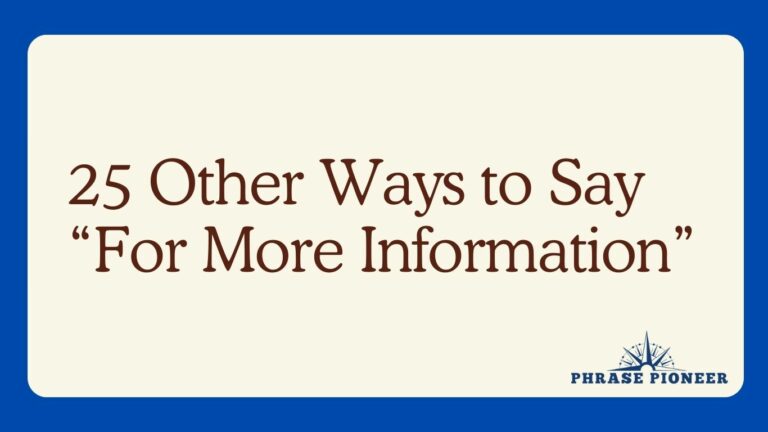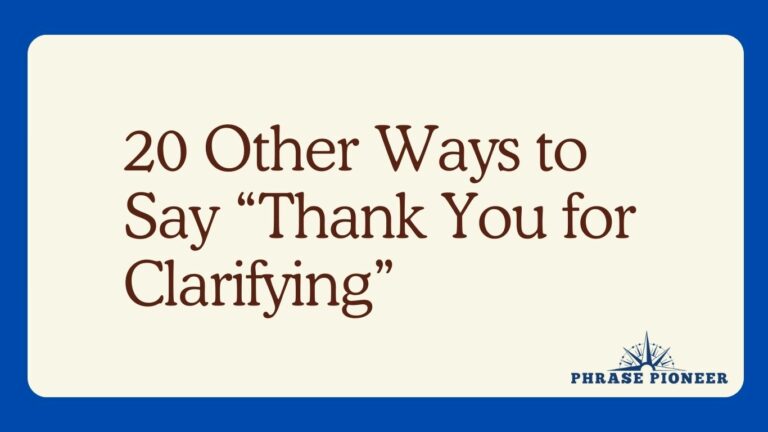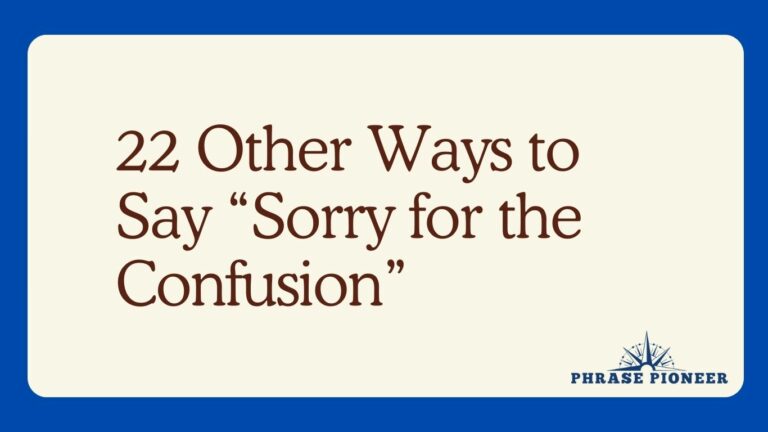23 Other Ways to Say “Just to Let You Know”
The phrase “Just to let you know” is often used to preface a statement where you want to impart information without necessarily requiring action or a response.
It can set the stage for an FYI, a heads-up, or simply share something of interest.
Here are 23 alternative ways to express this idea, each with an example sentence and an explanation for when and how they might be used.
Casual Informal Heads-Up
- FYI (For Your Information)
- Example: “FYI, the meeting tomorrow has been moved to the main conference room.”
- Explanation: A common abbreviation used to present information that could be useful or relevant to the recipient.
- Just so you’re aware
- Example: “Just so you’re aware, the boss is in a bit of a mood today.”
- Explanation: A gentle way to bring something to someone’s attention that they should be mindful of.
- Heads-up
- Example: “Heads-up: the parking lot will be closed for maintenance this week.”
- Explanation: Often used to provide an advance warning or notice about something that might affect the recipient.
- Thought you should know
- Example: “Thought you should know, your interview article was a huge hit on our blog!”
- Explanation: Implies that the information being shared is something the recipient would be interested in or happy to hear about.
- Giving you a shout to tell you
- Example: “Just giving you a shout to tell you that the documents you asked for are ready for pickup.”
- Explanation: A casual and friendly way to inform someone of something, likely between acquaintances or colleagues.
Prefacing Statements
- Wanted to mention
- Example: “Wanted to mention that the office will be closed Monday for the holiday.”
- Explanation: Indicates a thoughtful intention to share a piece of information that may not be widely known yet.
- By the way
- Example: “By the way, there are leftover pastries in the break room if you’re interested.”
- Explanation: A conversational segue used to insert a pertinent piece of information into the dialogue.
- You might like to know
- Example: “You might like to know that your favorite author is doing a book signing this weekend.”
- Explanation: When sharing something that is likely to be of particular interest or value to the recipient.
- It might interest you to know
- Example: “It might interest you to know that stock prices have surged this morning.”
- Explanation: Sets up information that’s presumed to be relevant or beneficial to the recipient’s interests.
- A quick note to say
- Example: “A quick note to say that the deadlines have shifted for the project submissions.”
- Explanation: A polite and succinct way to share an update or piece of information, typically in written communication.
Formal Notifications
- In the interest of keeping you informed
- Example: “In the interest of keeping you informed, management has decided to implement a new IT policy.”
- Explanation: A more formal announcement that aims to disclose changes or updates professionally.
- Please be advised
- Example: “Please be advised that the company retreat has been rescheduled for the spring.”
- Explanation: A formal and impersonal way to inform someone, often used in official notifications or advisories.
- We wish to inform you
- Example: “We wish to inform you that our terms of service have been updated.”
- Explanation: A polite, corporate approach to delivering information that may affect the recipient.
- For your consideration
- Example: “For your consideration, I have included the latest market research in my report.”
- Explanation: When presenting information that is meant for review or deliberation, particularly in a formal or professional context.
- Kindly note that
- Example: “Kindly note that your subscription will be renewed automatically unless canceled.”
- Explanation: A polite directive to pay attention to something important, often seen in written correspondence.
Conversational Disclosure
- I’ll fill you in
- Example: “Don’t worry about missing today’s brief; I’ll fill you in on the details.”
- Explanation: Indicates a willingness to provide the recipient with information they may have missed.
- You’d be interested to know
- Example: “Since you’re looking at buying a new car, you’d be interested to know there’s a sale next weekend at the dealership.”
- Explanation: Preface to information that is likely to be of specific importance or relevance to the recipient.
- For your awareness
- Example: “For your awareness, the client has altered their requirements for the project.”
- Explanation: Used to update someone with information they need to be conscious of, especially regarding changes which may affect their work or decisions.
- This is to inform you
- Example: “This is to inform you that the venue for the annual conference has changed.”
- Explanation: This formal statement transitions into an imparting of information, typically used in official communications.
- Just dropping a line to let you know
- Example: “Just dropping a line to let you know that I’ll be in your city next month—maybe we can meet up!”
- Explanation: A friendly and casual update, often suggesting a conversation or physical meeting to follow.
Pointed Intimations
- I thought I would tell you
- Example: “I thought I would tell you that our team was praised at the executive meeting today.”
- Explanation: Reflects a deliberate choice to share news or information that may have a positive impact or be morale-boosting.
- Be informed that
- Example: “Be informed that current weather conditions may lead to flight delays.”
- Explanation: A neutral and a somewhat detached way of introducing information, often in situations requiring caution or preparation.
- Just a heads-up that
- Example: “Just a heads-up that I’ve left the keys at the front desk for you.”
- Explanation: A friendly and often informal caution or notice regarding something the recipient should be aware of.
These alternatives provide a range of tones and levels of formality to suit different situations and relationships.
They are useful for delivering information in a way that is in sync with your conversational style or the expectations of the setting in which you’re communicating.







